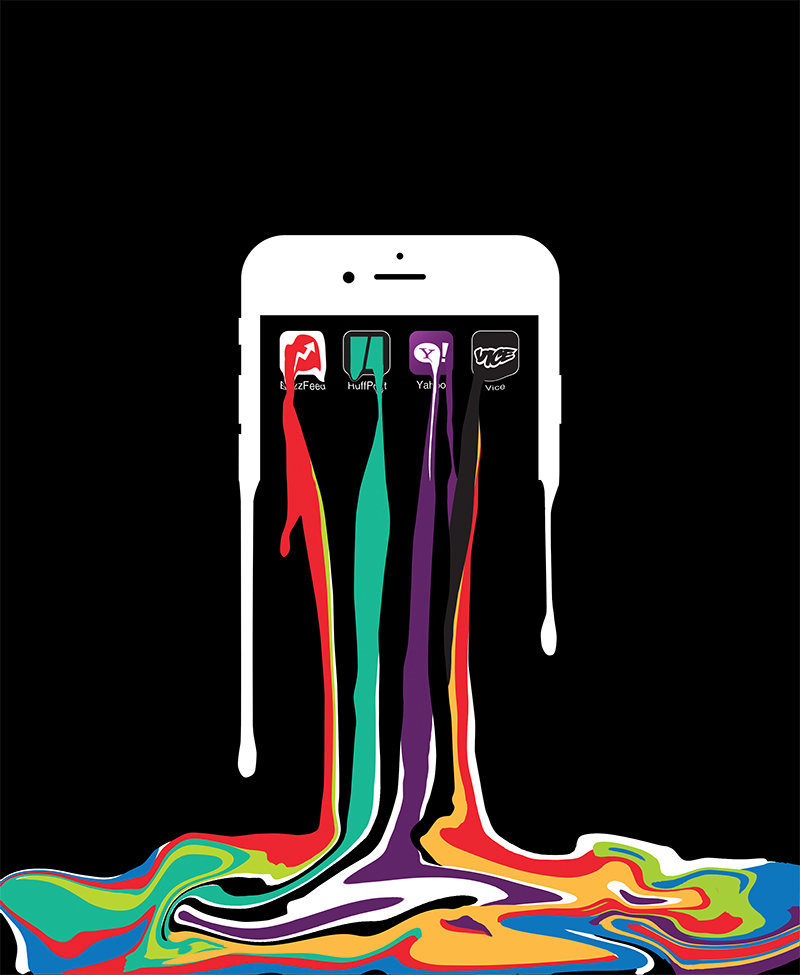
“I am laid off. I put up my little lay-off tweet and watch my mentions, inbox, private messages, and WhatsApp go straight to hell. Mostly people are very nice, and send their well wishes and job suggestions.”
That’s what Emily Tamkin wrote in her journal on Jan. 25, the day she found out that she had been laid off from her job as a foreign affairs reporter at BuzzFeed.
Tamkin was just one of more than 1,000 people laid off at the end of January amid a culling of talent by digital media companies like BuzzFeed, Vice, Yahoo and HuffPost. Sadly, job cuts at media companies aren’t exactly a new phenomenon, and newspaper companies like Gannett and McClatchy piggy-backed on the news to shed jobs of their own.
Even amid a backdrop of decreased revenues and longterm instability in the industry, the jobs cuts at outlets like BuzzFeed were depressingly grim, views by many in the industry as yet another sign the promise of a digital media oasis was nothing more than a mirage.
“What if there is literally no profitable model for digital news?” MSNBC host Chris Hayes wrote on Twitter following news reports about the layoffs. “It’s a crisis.”
Of the digital media companies to announce layoffs, easily the most shocking to journalists were the 250 or so people shown the door at BuzzFeed, the quiz-creating home of some of the most popular and viral content on the internet. After all, if the website that seemed to have its pulse on popular internet culture couldn’t figure out how to turn a profit online, what hope do any of us have?
The cuts at Vice were less surprising, given that in the fall of 2018 the company put a hiring freeze in place. But this is also the same high-flying media company valued at $5.7 billion as recently as the summer of 2017, according to the Wall Street Journal. It’s also a company that seems to embody the idea of owning a diversified revenue stream, considering Vice owns a cable network, produces shows for HBO, operates its own ad agency and even owns a bar in London called the Old Blue Last.
Compared to BuzzFeed and Vice, the total jobs lost at HuffPost were much smaller (reportedly around 20 employees). But they were part of a larger cost-cutting effort by parent company Verizon, which shed about 7 percent of its workforce across HuffPost, Yahoo and AOL—about 800 jobs.
 Jeremy Littau
Jeremy Littau
As grim as any job losses in journalism can be, especially considering the cost-cutting and job slashing that has plagued the industry for the last 10 years, many media experts don’t think these latest digital media cuts are the “canary in the coal mine” they were painted as after the cuts were first announced.
“I’ve been very cautious about anything I’ve read that lumps the three of them together as digital media companies because of the very different type of content they produce and the type of audience they’re chasing,” said Jeremy Littau, a journalism professor at Lehigh University. “I think they’re going through the growing pains of a market that has become saturated and is now starting to consolidate. There’s just too many players.”
Will Digital Ads Ever Support Content Creation?
It’s not as if advertisers aren’t spending money online. According to a recent report by eMarketer, 2019 is expected to be the first year in history digital ad spending will outpace traditional media ad spending (such as newspapers, magazines and television). Their research shows companies will be spending more than $129 billion on digital advertising in 2019, and is predicted to balloon to more than $172 billion by 2021.
So, why aren’t digital media companies able to sustain themselves online, even as digital advertising is sky-rocketing? Two words: Facebook and Google.
The large majority of those advertising dollars are being spent on search (Google), social display (Facebook), and video display (dominated by YouTube, which is owned by Google). All told, Google and Facebook sucked in slightly less than 58 percent of all digital ad spending in 2018, with Amazon coming in a close third with about 4 percent.
That leaves just about 38 percent for every other online company, including digital media outlets and newspapers, to fight over.
Bill Day, a vice president at the media research and consulting firm Magid, said the layoffs at BuzzFeed, Vice and HuffPost were more a market correction than a cataclysmic shift in the future of digital media. But he also doesn’t have much optimism about the long-term success of companies that remain heavily reliant on digital advertising dollars.
“Digital media companies built themselves on a business model that’s proven to not have any underpinnings, which is this idea that you can somehow support content creation with digital advertising,” Day said. “There’s virtually no examples in the ecosystem where that’s happening.”
Most of these companies were able to wash over problems in the digital advertising market thanks to a healthy dose of nine-figure investments. BuzzFeed alone has raised $497 million, yet despite being valued at $1.7 billion by research firm CB Insights, has yet to turn a profit, according to the Los Angeles Times.
Certainly BuzzFeed was too reliant on Facebook in its drive to grow traffic, especially when it came to the companies news initiative. That became all-too-clear when the social media giant made changes to its newsfeed in 2018 and left BuzzFeed dangling in the wind. As a source told Digiday, “Stories that once reliably gathered 200,000 visits through Facebook were suddenly lucky to get 20,000.”
Instead of overly-general websites that are duplicating the same type of national content, Day said companies like BuzzFeed should use this latest paring down to re-focus on a core mission that can be supported by a diverse revenue stream that includes a mix of support from advertisers and consumers.
As an example, PBS has existed in the news ecosystem for 60 years, and they’ve been competing side-by-side with the big three networks every night at 6 p.m. The network benefits from a business model built around foundation and corporate giving, and as a result, there’s little to no pressure to provide a return on investment.
“If I were running Vice or BuzzFeed, the question that I would want answer is if there is a space we can attack and own and become known for well enough that consumers would be willing to pay to engage with us,” Day said.
Consolidation Coming?
Back in November 2018, months before the company’s latest job cuts, BuzzFeed CEO Jonah Peretti floated the idea of merging with companies like Vice and Vox Media in an attempt to create more leverage and garner a higher percentage of ad dollars from companies like Facebook and Google.
“If BuzzFeed and five of the other biggest companies were combined into a bigger digital media company, you would probably be able to get paid more money,” Peretti told the New York Times.
Group Nine Media CEO Benjamin Lerer, Vox Media CEO Jim Bankoff and Refinery29 co-founder and co-CEO Philippe von Borries all signaled to the Times that digital media consolidation was inevitable.
But Lerer, who oversees popular media companies like Thrillist, NowThis and The Dodo, thinks many of these digital media companies get off too easy when they blame Facebook and Google for all their business woes.
"Most publishers have a problem with that monetization model because they don't make stuff that people actually spend time with," Lerer said on Ad Age’s Ad Lib podcast in February. "If you make a bunch of stuff that no one cares about and you whine, 'Why is no one paying for it?' That's your fault. That's not the fault of the platform. You have to make stuff that people actually care about and spend time with and stay through ads. And we've been able to do that at scale."
Consolidation certainly makes sense to Littau, who compared the crowded screen of digital media companies reporting on national politics to the overstuffed newsstands of the mid-19th century. Back then, a shift to steam-powered printing made it possible for upstart newspapers to flood the market at a cost of just one cent. That led to an over saturation of newspapers in places like New York City, paving the way for mergers and consolidation.
“I think we’re headed for some sort-of consolidation across the industry,” Littau said. “And so whatever major news brand survives that are national players, somebody’s got to make a choice. Do we want to be a general interest site like HuffPost, or do we want to be something with a specific focus?
The Netflix Lesson
As newspapers continue to press for more relevance and revenue in the digital space, they rightly view companies like BuzzFeed and HuffPost as competition for both ad dollars and attention. Instead of looking around at other digital media companies, maybe news executives should be eyeing Netflix instead.
According to Day, Netflix has done three things exceedingly well that are good markers for anyone who’s looking at creating a sustainable digital content creation business, and it all starts with creating and syndicating content that users are willing to pay to access. Netflix has also managed to create a compelling user experience across all platforms, making it easy to consume and discover new content.
 Bill Day
Bill Day
Most importantly, and most relevant to media companies, Netflix puts the consumer at the center of the process instead of designing a platform based around the delivery of advertisements (or worse—choosing a content management system based on your newsroom’s workflow). Instead, Netflix pairs an easy-to-use format with a recommendation engine based on what users have viewed in the past to intuitively serve up the next bits of content.
“It uses design to drive you towards the things that are most relevant to you while also giving you access to things that you might not have known you wanted,” Day said. “That serendipitous discovery is a critical part of the value that newspapers have traditionally brought into the landscape.”
It’s easy to brush away the Netflix model as being unrealistic to media companies. But it’s worth pointing out that while a paywall strategy still depends on digital advertising (unlike Netflix), survey after survey clearly shows that readers don’t necessarily object to ads—they object to a disruptive user experience.
“If ads are getting in the way of them consuming content, that’s what they object to,” Day said. “But they can also object if your system is slow, if there’s no easy way to authenticate, if they can’t find the right entry point.”
The Future
There is no reason to think that BuzzFeed, Vice and HuffPost are going anywhere anytime soon. All are well funded, have developed sizable audiences and still generate sizable revenue (though aren’t necessarily profitable).
The keyword to keep in mind is evolution. Though all three of these digital media companies have been revolutionary in their own unique ways, all took difficult steps in the hope to continue to survive and compete in an increasingly complicated and crowded ecosystem.
In internal memos obtained by E&P, BuzzFeed CEO Jonah Peretti outlined that the path forward for the newly-restructured company would place the focus on commerce and brand partnerships—areas that promise a meaningful return in revenue (the commerce division generated $50 million in sales in 2018, according to Bloomberg).
“We restructured to reduce our costs and ensure our future,” Peretti wrote to employees. “But, knowing we had to do that, we made strategic decisions on how to reshape our organization—so we can operate more efficiently while continuing to deliver for our audiences and grow.”
Despite that, Day is still unconvinced any media company can survive if their main source of revenue comes from digital advertising.
“I remain concerned about the ability of digital content to be supported by digital advertising,” he said. “So until those companies—newspapers included—find ways to do better with consumers and convince them to spend a small amount of money with them every month, it’s hard to see how this gets itself straightened out.”
Comments
No comments on this item Please log in to comment by clicking here